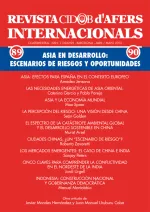Asia in development: risks and opportunities scenarios

Revista CIDOB d'afers internacionals, núm. 89-90
The statement that Asia has definitely awoken from its lethargy to become the most dynamic region on Earth as well as an emerging pole in international relations is hardly surprising today. Particularly, China and India have become two essential driving forces of the world economy due to their impressive economic growth, which they have managed to sustain over time, and to their large population numbers that when counted together represent more than a third of the world population. This fact has become even more evident with the recent downturn in western developed economies due to the financial crisis and the leadership role the two Asian emerging powers played in the global recovery process. Furthermore this highlights the possibility of them assuming a higher degree of responsibility in the development of a multi-polar international system. Such a significant rebalancing contains undoubtedly an ambivalent potential: on the one hand, even if this represents vast opportunities of cooperation and stimulation (for the Asians themselves, as well as for the rest of the World), on the other hand, it also entails considerable risks linked to the instability that these changes involve. From this double perspective, the aim of this issue of the Revista CIDOB d’Afers Internacionals is to analyse a wide range of possible scenarios. From a multidisciplinary approach, the articles focus on the economic (business, investments, scientific cooperation), environmental (climate change and environmental security), and political issues (such as the role of the United States and the rise of Chinese power, the ethnic conflicts in Northeast India or the complex process of construction of the contemporary Indonesia). These are a set of analysis that aim to facilitate the understanding of one of the most crucial issues of our time.
ISSN: 1133-6595 (edición impresa) / ISSN: 2013-035X (edición en línea)